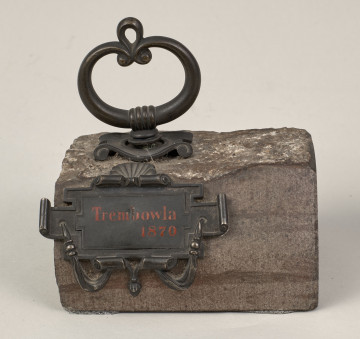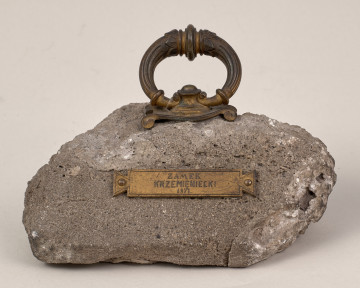
Paperweight
XIX century
Castle Museum in Łańcut
Part of the collection: Weapons, music instruments, varia
Human memory is unreliable, it is better to write down your thoughts so that they do not fly away. Writing is an art that is one of the milestones of human civilization.
All you need to write is a blank sheet of paper, a pen, ink (increasingly replaced by word processors, mice, etc.) and you can create the next national epic. To make it not too easy, the ink stains the sheets of paper, stains the fingers, but tissue paper can remedy this. Once we have dealt with the ink and stains, we sit down and "pour" our thoughts onto paper. We're sitting, we're writing with enthusiasm, and then someone walks in the room, opens the door, opens the window, and this treacherous wind blows the written and unwritten pages to the floor, mixing everything up. The poor creator had to pick them up, often on his knees, and his back hurts from sitting. When he has already collected the pages, it turns out that they are mixed up, and he forgot to number them and, to make matters worse, a few pages were forgotten during the collection and in fact they should be rewritten. Finally, we manage to put the written pages in order and we sit down to continue our work, and then someone comes in again on an urgent matter, someone opens the second window and again we have confetti from our written pages and we start collecting our written "golden thoughts" from the beginning. After a few such visits, we forget our own thoughts, discouragement creeps in, and because of such a small zephyr, some "epoch-making" work may not be created. And yet it was enough (with the exception of locking the doors and windows) to hold the blank and written pages with some heavy object, but not so heavy as to destroy the sheets of paper. Such an object is a paperweight, which is sometimes a small work of art in the form of a figurine, a plaque made of alabaster or glass, or other materials that are pleasing to the eye. They can also be very simple elements, such as various types of stones collected during trips to places sentimentally close to the collectors or related to the history of family or country. In this way, the paperweight became an indispensable desk equipment next to the inkwell, pounce pot, tissue paper, pen holder, lamp, and just like them, it took on different forms and shapes depending on the fashion prevailing in art at a given period. Paperweights, thanks to their form/shape and the material they are made of, complement the décor of the desk – those made of wood evoke the impression of warmth, those made of metal, especially precious metals, add majesty, and those made of glass or crystal, thanks to reflections, give the character of ephemerality like written thoughts. The most ordinary ones in the form of stones remind us of the places we have been to. They can also remind us of past centuries and events that determine our history and heritage.
The discussed paperweights from the collection of the Museum – Castle in Łańcut come from the collection of the Potocki family and belong to the latter category. They come from places currently outside the country (Borderlands) related to the history of Poland. One of them is the paperweight with the inv. no. S.4980MŁ, is in the shape of a lying stone irregular cuboid with one side polished and the other irregularly rounded and a wall with a slightly smoothed plate at the top. It has a round brass handle mounted on the same material, an elongated decorative plate decorated with a shell motif, attached to the stone without visible fastening studs, with the inscription "Sobieski Złoczów - 1870". Some places gain fame because of the historical events in which they appeared (see Trębowla, Kamień Podolski), others because of famous people who lived there or owned them. It is to the latter category that the paperweight with the inv. no. S.4989MŁ from Złotów belongs. Złoczów, a town located on the Złotówka River, is mentioned in sources from the mid-16th century as the property of the Sienieński, Zborowski and Górka families, from whom Marek Sobieski (a courtier and friend of Stefan Batory) bought the town. For almost 150 years it remained in the hands of this family. After the death of Marek Sobieski (1605), the estate was passed on to Jakub Sobieski, who in the years 1634-1636 erected a new brick Castle based on the assumptions of the bastion system in force at that time in the new Dutch style. The castle maintained in the palazzo in forteca type and was located on a hill towering over the south-eastern edge of the town. The fortifications of the castle were high ramparts, closing the square with four bastions at the corners. The bastions as well as the connecting curtains were additionally protected by a deep moat. After the Cossack wars, Jan Sobieski (who inherited Złotów from his mother) renovated the Castle and strengthened the garrison, which in 1672 did not bring any effect, because after 6 days of siege the Turks captured the Castle and garrisoned it with their own crew. However, in 1675 the fortress put up an effective Tatar-Turkish resistance and despite repeated attacks of the overwhelming forces, the Castle was not conquered. Złoczów remained in the hands of the Sobieski family until 1740, when it passed into the hands of the Radziwiłł family, and in 1801 it was put up for auction and bought by Count Łukasz Komarnicki. In 1834, Łukasz's son Aleksander Komarnicki leased the castle into a barracks, and in 1872 the Austrian government turned it into a prison. In this way, from the residence of one of the greatest kings and leaders of the First Polish Republic, the Castle becomes a prison where the invaders hold the compatriots of the victor from Chocim and Vienna. In the years 1818-1919, during the fighting, the Castle again became a witness to the death of our compatriots murdered by the Ukrainians, including the poet Ludwik Wolski. After years of peace of the Second Polish Republic, in 1939 the Soviet army organized the NKVD torture chambers in the castle, where the representatives of the local population, especially of Polish origin, were tortured. In June 1941 the Soviets murdered 650 to 720 prisoners of the Złoczów castle. In the following years (1941 – 1944) the function of the castle remained the same, i.e. it was still a prison and torture chamber, only this time the executioners were the Gestapo. We can only hope that after the recent geo-political changes, this function of the castle will not return, which may guarantee the opening of a branch of the Lviv Art Gallery in the renovated castle.
Thanks to such inconspicuous objects such as this paperweight, the history of the nation, the national identity and the memory of the old days and heroes of the Eastern Borderlands are preserved.
Przemysław Kucia
Object type
pamiątki
Material
stone
Creation time / dating
Owner
Muzeum - Zamek w Łańcucie
Identification number
Location / status

XIX century
Castle Museum in Łańcut

Castle Museum in Łańcut

XIX century
Castle Museum in Łańcut
DISCOVER this TOPIC
Castle Museum in Łańcut
DISCOVER this PATH
Educational path